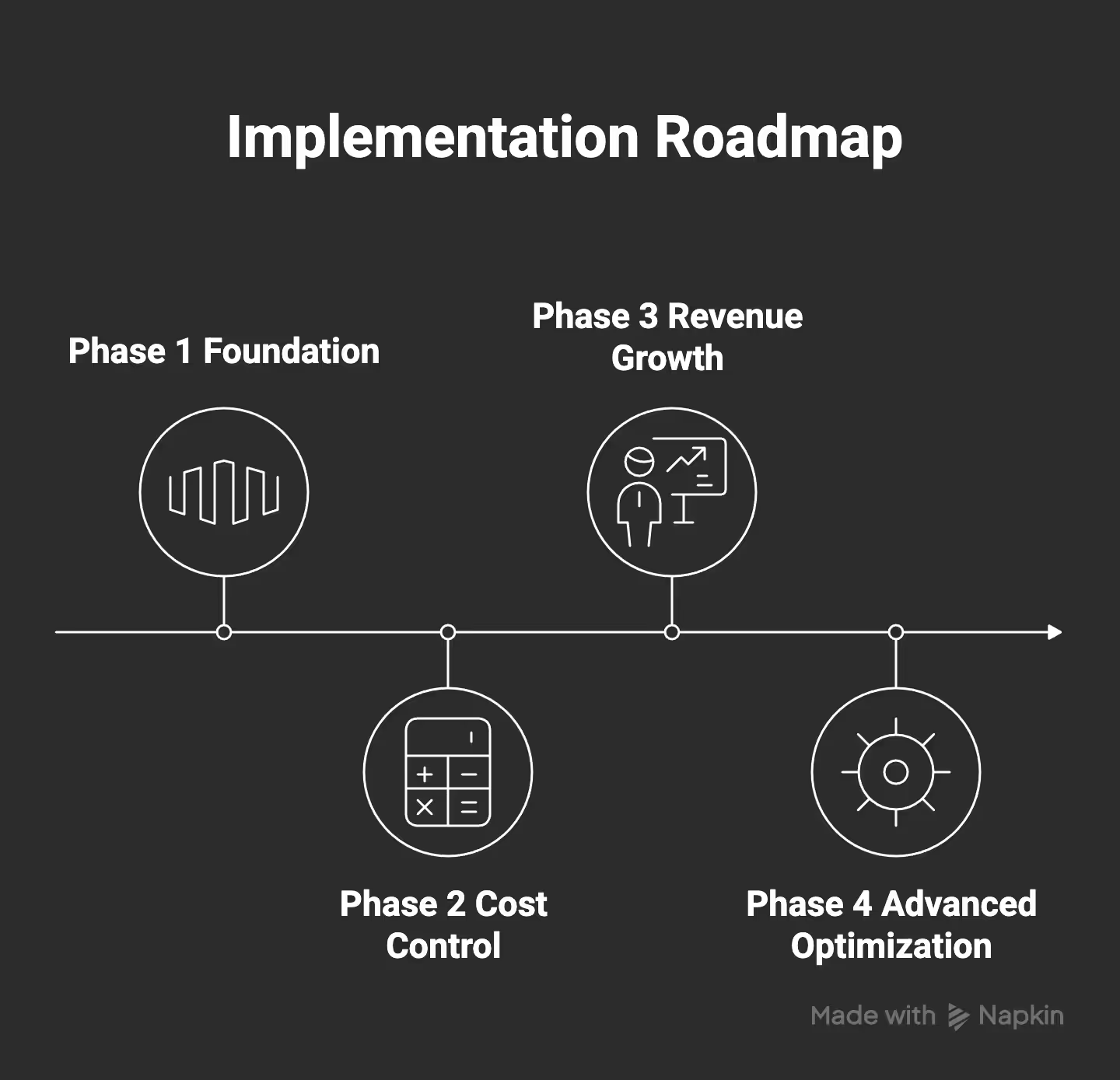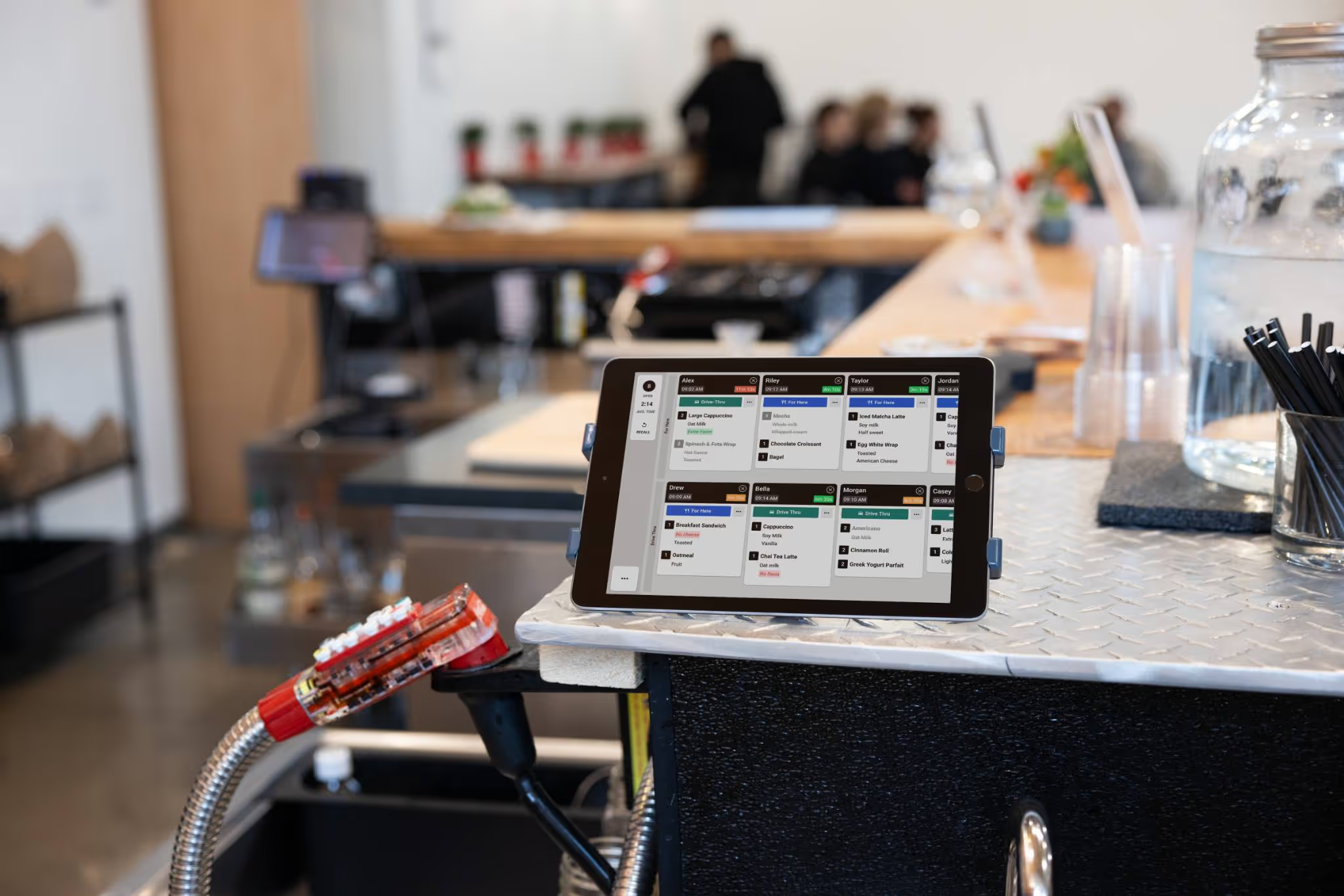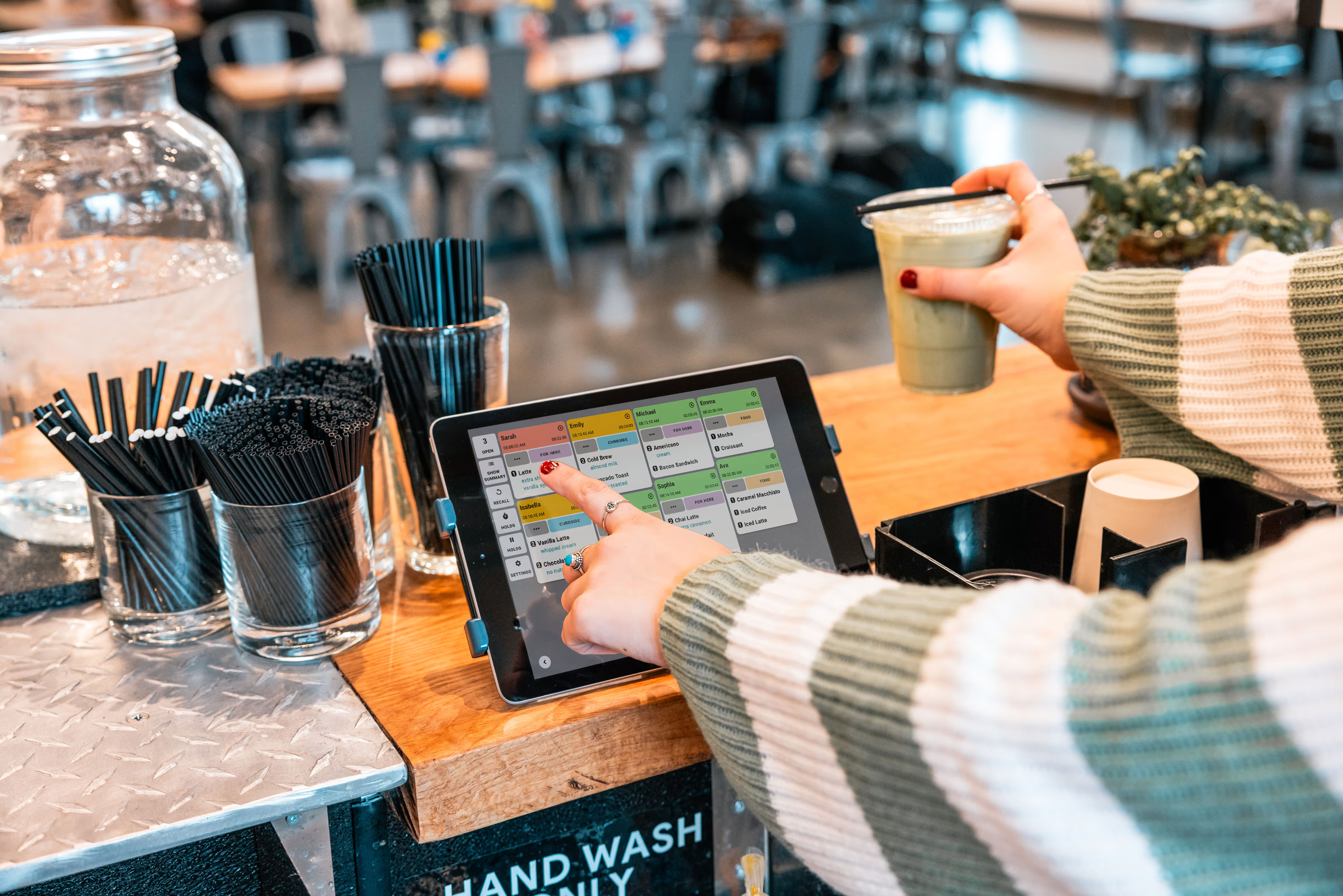Restaurant margins are razor-thin—often just 3-5%—and operators waste thousands monthly on disconnected systems, manual processes, and poor visibility into their numbers. The right software stack can be the difference between thriving and barely surviving.
If you're shopping for software for restaurants, you're really building a connected ecosystem—tools that help you market your restaurant, schedule employees, prep food, prepare orders, and account for all these transactions in sync. Smart choices can reduce food waste by 15-25%, cut labor costs by 2-4%, and increase repeat visits by 20-35%. Below is a practical review of the major categories, what each delivers, and how they work together to transform your operations.
Point of Sale (POS) Systems
Why it matters: Your POS is the central nervous system of your restaurant. It captures every sale, routes orders seamlessly, syncs menus across channels, and feeds critical data to inventory, accounting, and marketing systems. Without a solid foundation here, everything downstream suffers.
Business impact: 30-50% faster checkouts, 95%+ order accuracy, real-time sales visibility, and clean data that powers smarter decisions across your operation.
Implementation timeline: 4-6 weeks including setup, training, and go-live support.
.avif)
Leading Providers Comparison
Kitchen Display Systems (KDS)
Building on your POS foundation, a KDS eliminates the chaos of paper tickets while connecting your front and back of house operations seamlessly.
Why it matters: Paper tickets create bottlenecks, errors, and communication gaps. KDS synchronizes all stations, prioritizes orders intelligently, and consolidates third-party delivery orders into one unified flow.
Business impact: 15-25% reduction in remake costs, 30-45 second improvement in average ticket times, and 90%+ improvement in order accuracy during rush periods.
Implementation timeline: 1-2 weeks for basic setup, 3-4 weeks for complex multi-station configurations.
Leading providers:
- Fresh KDS: Best for quick deployment - Lightweight, tablet-based system that works on iOS/Android. Get started in days, not weeks. Perfect for independents and small chains.
- Square KDS: Best for Square users - Native integration eliminates sync issues and simplifies training.
- QSR Automations ConnectSmart® Kitchen: Best for high-volume operations - Enterprise-grade system handling 1,000+ tickets per hour.
- Oracle MICROS KDS: Best for demanding environments - Military-grade hardware for 24/7 operations.
.avif)
Labor Management & Scheduling
With your sales and kitchen operations optimized, the next critical piece is controlling your largest controllable cost: labor.
Why it matters: Labor typically represents 25-35% of revenue. Even a 1% improvement in labor efficiency can increase profit margins by 15-20%. Modern scheduling tools use sales forecasts to right-size staffing while ensuring compliance.
Business impact: 2-4% reduction in labor costs, 50% less time building schedules, 60% fewer no-shows, and automatic compliance monitoring that prevents costly violations.
Implementation timeline: 2-3 weeks including payroll system integration and staff onboarding.
Leading providers:
- 7shifts: Best for restaurant-specific needs - Built by restaurant operators, includes tip management and retention tools.
- Homebase: Best for budget-conscious operators - Free tier available, strong SMB focus with HR add-ons.
- Deputy: Best for AI-powered forecasting - Uses machine learning to predict optimal staffing levels.
Inventory & Food Cost Management
Now that you're controlling labor, it's time to tackle the other half of your prime costs: food and beverage inventory.
Why it matters: Food costs can vary by 3-5% based on inventory practices alone. Digital invoice processing, recipe costing, and automated reordering prevent waste while maintaining consistency.
Business impact: 15-25% reduction in food waste, 2-3% improvement in food cost variance, 75% less time on weekly inventory counts, and real-time alerts on price volatility.
Implementation timeline: 3-4 weeks including vendor onboarding and recipe setup.
Leading providers:
- MarginEdge: Best for invoice automation - Processes 95%+ of invoices automatically, includes bill pay workflows.
- MarketMan: Best for recipe costing - Precise COGS tracking with real-time recipe calculations.
- Craftable: Best for beverage programs - Excels at complex drink recipes and multi-vendor ordering.
- Apicbase: Best for enterprise chains - Full back-of-house ERP for multi-unit operations.
.avif)
Online Ordering & Delivery Management
With your operations optimized, it's time to expand revenue through digital channels while protecting your margins.
Why it matters: Off-premise now represents 40-60% of sales for many concepts. Direct ordering channels preserve 15-30% commission fees while giving you complete control over guest data and experience.
Business impact: 20-40% increase in average order value through upselling, 100% guest data capture vs. 0% from third-party platforms, and 15-30% margin improvement on direct orders.
Implementation timeline: 2-4 weeks including menu setup, payment processing, and marketing integration.
Leading providers:
- Olo: Best for enterprise brands - Powers 400+ major restaurant chains with robust API ecosystem.
- ChowNow: Best for commission-free ordering - No per-order fees, strong local marketing tools.
- Flipdish: Best for international operations - Global platform with localized payment methods.
- DoorDash Storefront: Best for hybrid approach - Commission-free direct ordering with DoorDash logistics option.
.avif)
Accounting & Back-Office
With revenue flowing from multiple channels, you need systems that consolidate financial data and provide real-time visibility into your performance.
Why it matters: Manual bookkeeping delays decision-making and increases errors. Restaurant-specific platforms automatically categorize transactions, manage accounts payable, and generate daily P&Ls that help you spot trends before they become problems.
Business impact: 75% faster month-end close, daily P&L visibility vs. weekly/monthly, 90% reduction in manual data entry, and real-time cash flow monitoring.
Implementation timeline: 2-6 weeks depending on complexity and historical data migration needs.
Leading providers:
- Restaurant365: Best for restaurant-native features - Purpose-built ERP with inventory, labor, and AP automation.
- QuickBooks Online: Best for familiar interface - Widely-used platform with restaurant-specific guides and integrations.
- Xero: Best for app ecosystem - Cloud-native with extensive third-party integrations.
Marketing, Loyalty & Guest CRM
Finally, with operational efficiency locked in, focus on growing guest lifetime value through targeted marketing and loyalty programs.
Why it matters: Acquiring new customers costs 5-7x more than retaining existing ones. Modern CRM platforms unify guest identities across all touchpoints and automate personalized campaigns that drive incremental visits.
Business impact: 20-35% increase in repeat visit frequency, 25-40% improvement in marketing ROI through segmentation, and 15-25% boost in average check through targeted upselling.
Implementation timeline: 3-6 weeks including data integration, campaign setup, and staff training.
Leading providers:
- PAR Punchh: Best for enterprise chains - Powers loyalty for major brands with advanced segmentation.
- Paytronix: Best for end-to-end engagement - Combines loyalty, offers, mobile ordering, and analytics.
- Thanx: Best for data-driven insights - AI-powered platform that optimizes campaigns automatically.
- Olo Engage: Best for Olo users - Seamless integration with Olo ordering and kitchen systems.
How AI Is Revolutionizing Restaurant Operations
Artificial intelligence is moving from experimental to essential, with measurable ROI appearing across multiple operational areas.
Voice Ordering & Drive-Thru Automation
Current state: AI voice systems now handle 70-80% of drive-thru orders without human intervention, with accuracy rates exceeding 95% for standard menu items.
Business impact: 15-20% reduction in drive-thru labor costs, 30-45 second improvement in service times, and 24/7 order capture capability.
ROI timeline: 6-12 months for most implementations.
Best for: QSR chains with high drive-thru volume and standardized menus.
Leading provider: SoundHound AI offers omnichannel voice platforms purpose-built for restaurants.
Predictive Scheduling & Demand Forecasting
Current state: Machine learning algorithms analyze historical sales, weather, events, and seasonality to predict staffing needs with 85-90% accuracy.
Business impact: 2-4% reduction in labor costs through optimized scheduling, 50% reduction in over/under-staffing incidents.
ROI timeline: 3-6 months.
Best for: Multi-unit operations with variable demand patterns.
Smart Inventory & Dynamic Pricing
Current state: AI systems predict ingredient needs, detect price anomalies, and recommend menu pricing adjustments in real-time.
Business impact: 10-15% reduction in food waste, 2-3% improvement in gross margins through dynamic pricing.
ROI timeline: 6-9 months.
Best for: Restaurants with complex inventory or frequent price volatility.
Personalized Marketing at Scale
Current state: AI engines create individual guest profiles and automate 1:1 offers across channels, optimizing for lifetime value rather than immediate sales.
Business impact: 25-40% improvement in campaign effectiveness, 15-20% increase in guest retention rates.
ROI timeline: 3-6 months.
Best for: Brands with substantial guest databases and multiple locations.
Implementation considerations: Start with one AI application, measure results carefully, and maintain human oversight for complex scenarios. Most successful implementations begin with predictive scheduling or voice ordering where ROI is most measurable.
Your Implementation Roadmap

Phase 1: Foundation (Weeks 1-8)
- Deploy your POS as the system of record - validate integrations before final selection
- Install KDS to eliminate paper tickets and centralize order flow
- Set up basic reporting to establish baseline metrics
Phase 2: Cost Control (Weeks 6-12)
- Implement labor management with sales-based scheduling
- Deploy inventory management starting with your highest-cost ingredients
- Integrate accounting to automate daily P&L generation
Phase 3: Revenue Growth (Weeks 10-16)
- Launch direct online ordering to capture guest data and protect margins
- Activate loyalty/CRM once you have 90+ days of clean guest data
- Optimize with analytics using integrated reporting across all systems
Phase 4: Advanced Optimization (Weeks 14+)
- Pilot AI features with clear KPIs and success metrics
- Expand integrations based on operational bottlenecks
- Scale successful implementations across additional locations
Red Flags: What to Avoid
During vendor evaluation:
- Providers who can't demonstrate live integrations
- "Coming soon" promises for critical features
- Pricing that seems too good to be true (often means hidden fees)
- No clear data export/migration path
- Vendors with poor support ratings or limited restaurant experience
During implementation:
- Rushing go-live without adequate testing
- Insufficient staff training time
- Not having backup systems during transition
- Skipping integration testing between systems
Data Security & Compliance Considerations
Modern restaurant software handles sensitive payment data, employee information, and guest details. Ensure your stack includes:
- PCI DSS compliance for payment processing
- End-to-end encryption for all data transmission
- Regular security audits and penetration testing
- GDPR/CCPA compliance for guest data management
- Secure API authentication between integrated systems
- Regular backup and disaster recovery procedures
Budget 5-10% of your software costs for security and compliance requirements.
Success Metrics to Track
Operational Efficiency
- Average ticket time (target: under 12 minutes for full-service, under 4 minutes for QSR)
- Order accuracy rate (target: 98%+)
- Labor cost as % of sales (track weekly trends)
- Food cost variance (target: within 0.5% of theoretical)
Financial Performance
- Daily/weekly P&L visibility
- Cash flow accuracy and timing
- Cost per acquisition vs. lifetime value
- Same-store sales growth
Guest Experience
- Online review scores and response rates
- Loyalty program engagement and retention
- Direct ordering vs. third-party mix
- Average order value trends across channels
Final Thoughts
Building the right restaurant software stack isn't about choosing the "best" individual tools—it's about creating a connected ecosystem that eliminates friction, reduces costs, and drives profitable growth. The operators thriving in 2025 are those who've moved beyond manual processes and disconnected systems to create seamless, data-driven operations.
Start with a solid POS foundation, add KDS to optimize kitchen flow, then layer on cost controls and revenue optimization. Most importantly, choose platforms that integrate cleanly and keep your data portable—vendor lock-in is expensive and limits your future flexibility.
For quick deployment with immediate impact, consider starting with a tablet-based KDS like Fresh KDS while you evaluate your broader tech stack. You can implement it in days, see immediate results in kitchen efficiency, and use those wins to fund your next system upgrade.

%20(1).avif)





.png)




.webp)


